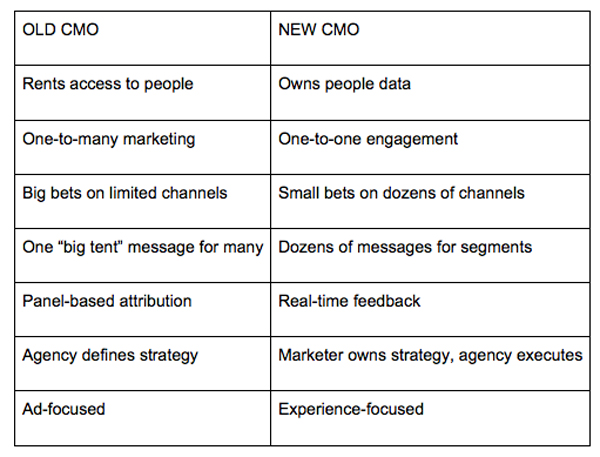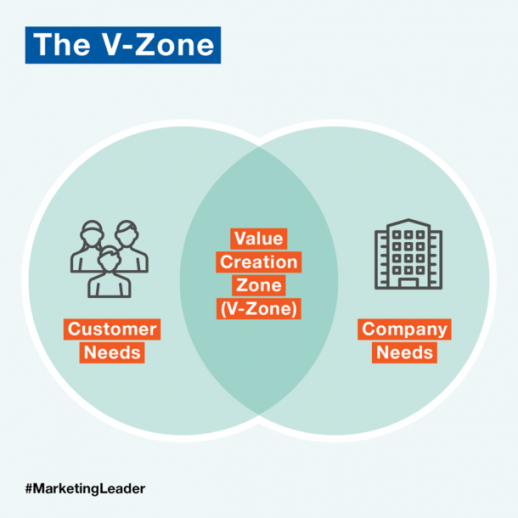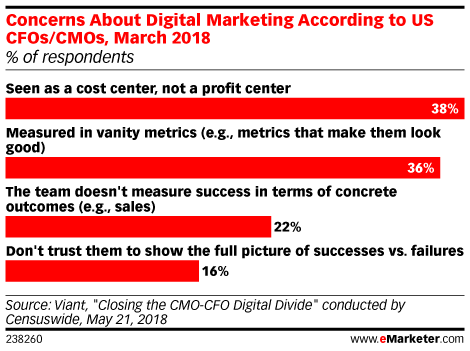Marketers, you may want to sit down for this: A recent study revealed that CMOs have the shortest tenure in the C-suite, a mere three years on average.
While there was a slight uptick in 2017, the tenure of CMOs has been on a steady decline for years. At the same time, expectations for the role have skyrocketed. A staggering 37% of CEOs say the CMO will be first in the firing line if growth targets aren’t met. With that kind of pressure, it’s not hard to see why they’re starting to crack.
The CMO revolving door has implications that go far beyond the C-suite. Aside from the CEO, CMOs have the most control and influence over how a brand is perceived than any other executive. When new CMOs come onboard, they’re usually under pressure to make big changes to brand messaging and direction. Constant changes result in inconsistencies that chip away at customer trust and can adversely affect revenue. With the consequences so dire and the risks so great, why are companies swapping out their CMOs so frequently?
5 Reasons CMOs Leave or Face the Boot
1. The Role Has Changed
A decade ago, most CMOs saw themselves as the brand ambassador and keeper of the story. Now they view themselves as business drivers and change agents. Jonathan Beamer, CMO of Monster, described the evolution this way:
“We have long been creatives and empaths—expected to get in the heads of those that we want to buy our products. Then we became scientists, learning to deploy customer research and experimental design to see if the stimuli we put into the world drove the reaction we expected. Over the past decade, we were increasingly expected to be accountable for the dollars we are trusted with and communicate well with our CFO partners. Now we also need to be technologists—to understand the myriad choices we have to target our messaging and track the responses it generates.”
Part of this transformation has to do with their new obsession with growth. More CMO’s believe they’re more responsible for growth than the CEO is, according to a recent Deloitte study. Ironically though, only 6% of them focus on revenue-generating activities. Assuming responsibility for growth is rife with risk.
Hubspot’s CMO Kipp Bodnar outlined the stakes this way: “You grow or you die. Growth is at a premium, but growth has become harder. Supply and demand are out of whack. It’s never been easier to start a company, but it’s also never been harder to grow one.’”
2. Mismatch Between Role and Expectations
The confusion over what a CMO is and isn’t responsible for doesn’t just stem from within. CEOs often have expectations about what they should do and the impact they should have, but they may not share them openly. When these expectations go unmet, CMOs find themselves in hot water.
A whopping 80% of CEOs don’t trust or are unimpressed with their CMO. The rest of the C-suite have much more clarity as their roles are more binary in nature. There’s no confusion about what the benchmarks of success are for a CFO. Nobody is wondering what the CTO is responsible for. But ask 10 people what a CMO should preside over and you’ll get 10 different answers.
CMO job descriptions typically don’t provide clarity either. A report in the Harvard Business Review found that only 22% mentioned how their performance would be measured and only 2% clearly articulated job expectations. Even when the job descriptions are clear, the skills and experience needed to carry out the job can vary immensely. Marketers often lack the same kind of foundational education that lawyers or accountants have, for example. In fact, only 6% of CMOs polled have a degree in marketing. This lack of clarity and alignment around what the role does and doesn’t entail is setting CMOs up for failure even before they’ve started.
3. The Role Is Disruptive By Nature
Besides having more clarity, the rest of the C-suite benefit from being primarily internal facing. CMOs, on the other hand, are directly responsible for the way customers, clients, and the press behave and interact with the company. Failures are more noticeable and felt much more deeply, both financially and through public perception.
This kind of risk is too much for most C-level execs to swallow, so they’ve started replacing the CMO role with CGOs, Chief Growth Officers. CGOs are masters at optimizing resources, providing consistent and quantifiable results, and can provide the data to back up their decisions—all of which is causing the C-suite to fall head over heels. Even Coca-Cola, a brand famous for marketing, dissolved their CMO role last year in favor of a CGO.
4. Short-term Thinking by Their Peers
Looking to satisfy investors, many CEOs and CFOs have focused on short-term, high-impact goals. There’s been a sweeping trend of outsourcing marketing initiatives to outside help. These agencies tackle short-term projects that are usually tied to revenue, making the impact of their work easily felt. With the progress so easily measured and the ROI so quantifiable, these limited engagements seem very appealing.
This addiction to quick wins has fostered a climate of “grow or go.” If CMOs can’t demonstrate ROI, they’re on the chopping block.
Progress on larger, more long-term goals is harder to measure. Most don’t have clear endpoints or quantifiable indicators of success. It’s also much harder to align the organization around things like consistent storytelling or brand perception.
“Sometimes it’s very easy to forget perception is everything,” says Bodnar. “CMOs can help drive the external perception. They can take complex things and make it simple for employees, external audiences, and the C-level.”
When brands only focus on short-term, easy to measure goals, they lose out on the lasting value that some of the longer term objectives can create.
5. CMOs Have Been Reckless with Their Budgets
Under pressure to deliver results, CMOs have thrown things against the wall just to see what will stick. Digital transformation has rapidly expanded the number of tools available to them, and they’ve been a little too quick open their wallets. Digital ad spend has grown out of control and members of the C-suite are getting fed up.
Questions are being raised about the effectiveness of this careless spending, and the results are making it hard to justify. As a result, some of the biggest brands are slashing their ad budgets, according to a report by Forrester. The world’s biggest advertiser, Procter & Gamble, cut their digital ad spend by $200 million last year alone with dozens of other brands following suit.
“For my next trick…”
All of these challenges are making it difficult for the modern CMO to generate impact and live up to their full potential. They’re feeling pressured to scrap long-term, more strategic goals in favor of short-term wins that buy them time and distract their audience. Longer-term plays feel like failures and bring heavy scrutiny. Left unchecked, CMOs can put more focus on securing their own place in the C-suite than satisfying the customer, which is ultimately where they can deliver the most value to the organization.
4 Ways CMOs Can Secure Their Place In the C-Suite
1. Make Growth a Top Priority
CEOs have high expectations for the role: 50% of them view CMOs as the primary drivers of disruptive growth. Today’s leading CMOs are rising to the challenge and delivering results by making the best use of their unique, customer-focused perspective.
They realize that “gut feeling” marketing doesn’t cut it in the digital era and that marketing is both an art and a science. Being a storyteller is still essential, but it’s also just as important to be a scientist. They’re taking the time to develop technical acumen and developing a curiosity that pulls them towards new and creative solutions. Combined with their deep empathy for the customer, they’re delivering unique insights to the organization that drives top line growth.
By embracing this growth focus, modern CMOs are changing the view of marketing from being a cost center to a revenue generator. They’re stepping up and making broader and more disruptive decisions that directly impact revenue, not just brand perception. While CGOs may have a leg up when it comes to tactics, data analysis, and technical skills, CMOs’ intimate knowledge of the customer can make those efforts even more impactful.
2. Focus On the Customer Experience
We’re well into the Age of the Customer. It’s no longer effective to interrupt people with your message. They have the tools and range of choice to ignore you or shut you out completely. Brands can only pay for the opportunity to interrupt, but the messages of the past no longer work. Consumers demand value from every brand interaction and have plenty of options to choose from if they don’t get it. CMOs must adapt and embrace their opportunity to be the organization’s foremost customer expert and advocate. Customers, after all, are the most valuable asset a company has.

The modern CMO has access to all kinds of data about their customers. They can use these insights to establish common ground and shared goals with other members of the C-suite.
“I look for opportunities to co-create with my peers,” explains Beamer. “In our business, product and marketing are incredibly connected, as are sales and marketing. We foster tight connections and formalize them with matrixed reporting structures and shared goals.”
CMOs can use their customer insights to:
- Influence development of the product/service with the CEO/CPO
- Discuss data collection and product expectations with the CTO
- Relay customer needs with the CRO and better equip sales teams
The space between customer needs and business needs is commonly called the V-Zone (Value Zone) and it’s where CMOs can create the most impact. This spot puts them squarely between providing value to customers while at the same time increasing revenue for the company.

Companies that prioritize the customer like Amazon, Netflix, and Disney are winning in the marketplace. Yet nearly half of all brands (47%) are failing in customer experience (CX). There’s a CX leadership gap, and CMOs are in the best position to fill it. It requires a mindset shift from “What do I need to sell to my customers?” to “What do my customers need?”. The data shows that CX is one of the biggest drivers of growth. Put simply: Better customer experience = higher revenue. To succeed in this endeavor, CMOs must keep the human context of their decisions front and center.
“We have so many ways that we abstract away our customer as we focus on the revenue they provide and refer to them as targets, prospects, or clicks,” says Beamer, Monster’s CMO. “We need to remember the human on the other side of the table; someone who loves our product, or is frustrated by our new feature, or is angry about a price increase—this is how we make business more real.”
3. Set the Right Expectations
The role of the CMO has changed, but that doesn’t mean CMOs have to let others define it for them. While perceptions are evolving, CMOs can take the lead in shaping those perceptions by outlining their areas of focus. By identifying the key areas of growth and getting buy-in from their C-suite peers, CMO can set themselves up for success.
Even before joining the org, the CMO candidate needs to work with the CEO to clearly outline the expectations of the role and how success will be measured. From the get-go, they need to ensure these metrics of success align fully with the scope of responsibilities and speak up if they feel they don’t have the authority or access they need. Setting expectations early and with the right people will ensure they can be successful in the role from the start.
4. Become Best Friends with Your CFO and CEO
One of the CMOs greatest “frenemies” in the C-suite is the CFO. From the CFO perspective, marketing is a cost center, a revenue drain instead of a revenue driver. “Likes” and “Shares” mean nothing to the CFO. In their minds, marketing spend has to have clear ROI and advance business outcomes.
To win over the CFO, marketers have to clearly show how their campaigns align with company goals. They can do this most effectively by becoming intimately familiar with the data and always be ready to share the numbers.

The CEO can be a CMO’s best partner in this. Both the CEO and CMO see the value of building relationships with customers and developing the brand. CEOs can use their influence to help CMOs defend their decisions, acquire more budget, and mitigate any failures. This requires CMOs to get full buy-in from the CEO on their ideas and clear alignment on strategies and tactics.

Embrace the Chaos
CMOs have an incredible opportunity before them to lead their organizations through digital transformation and navigate the Age of the Customer. To do this successfully, they need to be adaptable and invest in expanding their skills and influence. The key is embracing the growth agenda and mastering both the art and science of marketing. Their greatest asset is their deep understanding and insights about the customer. By using that knowledge effectively with their partners in the C-suite, they can create lasting value for the customer and the organization.
Leading CMOs are turning to collaborative work management tools to reign in the chaos, bring structure to their efforts and help their teams work more effectively. The visibility these tools provide is helping them win over all members of the C-suite, building trust through transparency, and bringing the entire org in alignment around their efforts. Check out our free buyer’s guide below to see how these tools can help you create impact and drive growth.




